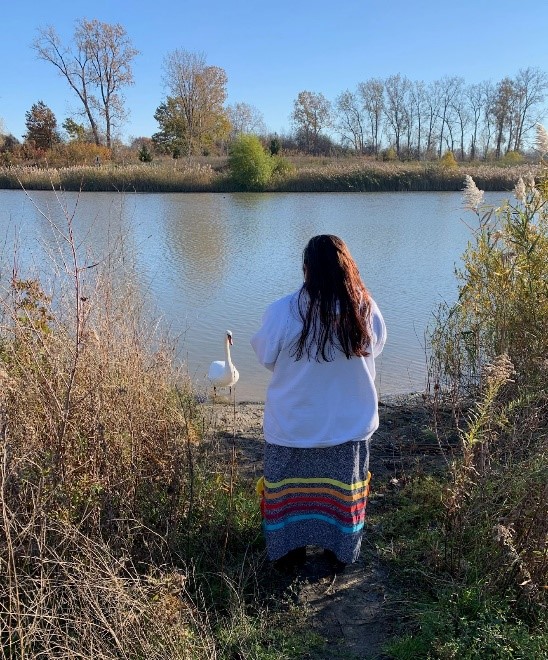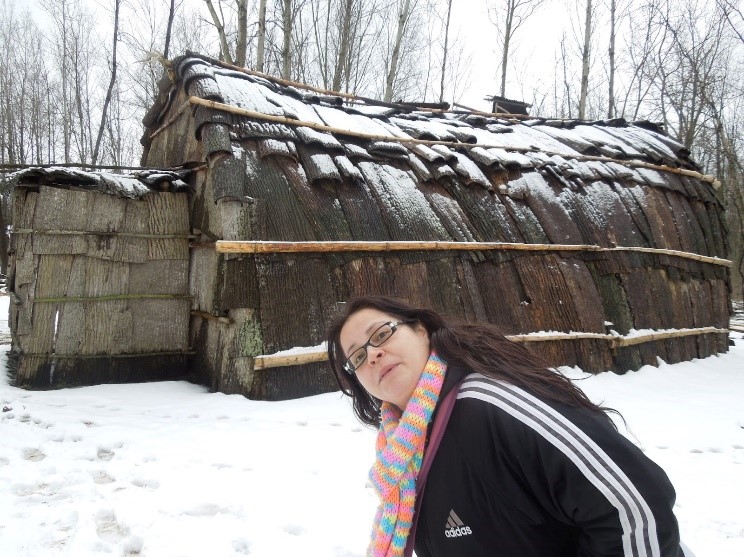5.1: The Importance of Place and Space
Land-Based Education
One of the most fundamental and basic principles of Indigenous pedagogies is interconnectedness to the land. The land is essentially inseparable from all learning, all elements of life, and embedded in spirit—hence the significance of the term—Mother Earth.
Some Indigenous languages also reflect this, which is one of the reasons why it is so tragic that so much loss of language has occurred from the effects of colonization. The English language is immersed and positioned around the use of nouns and possessiveness.
Robin Wall Kimmerer (a botanist, Professor and enrolled member of the Citizen Potawatomi Nation), shares a particularly striking passage in her book, Braiding Sweetgrass, that helps to illustrate this interconnectedness that doesn’t exist within the English language. According to Dr. Kimmerer, approximately 30% of words in English are verbs and in Potawatami, that number rises to approximately 70% (2013, p. 53). This is significant as it indicates the concept of experiencing the world in Indigenous tradition, rather than possessing it, as in Western tradition.

Watch The Importance of Land-Based Education [5:28] video to see an example of land-based lessons at the Black Oak Heritage Park.
Place-Based Education
Indigenous pedagogies connect learning to a specific place, and thus knowledge is situated in relationship to a location, experience, and group of people. For curriculum developers, this means creating opportunities to learn about the local place and to learn in connection to the local place. The following Importance of Place-based Learning [2:06] video explains place-based learning at the site of the Nimkii Binesi Zaswaaning (Thunderbird’s Nest![]() ).
).
The Learning Lodge on the Chippewa on the Thames First Nation (COTTFN) is being prepared as a site to host Indigenous learning, healing, and ceremony for its members. Connecting with Indigenous communities in your area may offer opportunities for place-based learning in your curriculum.

Experiential Learning
Experiential learning plays a significant role in Indigenous pedagogies. It has been used with Indigenous Peoples since time immemorial to equip generations with the knowledge, values, skills, spiritual, emotional, intellectual, and physical competencies needed to survive and thrive.

One contemporary view on experiential learning was undertaken by the University of Toronto when they developed a whitepaper exploring experiential learning as a strategic approach to enhance student learning while contributing to the larger community and societal needs. This view recognizes the value of holistic and multi-modal learning in addition to interacting with the learner’s environment.
From the whitepaper, the following was used to help refine an experiential learning definition drawing upon many western influential researchers including Kolb, Dewey, Lewin, and Piaget (University of Toronto, 2017):
Six Core Tenets of Experiential Learning Theory
Drawing on David A. Kolb’s (1984) theory, experiential learning is understood to be “the process whereby knowledge is created through the transformation of experience” (p. 38). Building upon earlier theories on learning through experience (Dewey, 1938; Lewin, 1951; Piaget, 1978), Kolb’s experiential learning theory (ELT) is founded on six core tenets (Kolb & Kolb, 2005):
- Learning is a process.
- Learning is grounded in experience.
- Learning involves mastery of all four learning modes.
- Learning is a holistic process of adaptation.
- Learning occurs when an individual interacts with their environment.
- Knowledge is created through learning.
Dr. Marie Battiste (2002) summarizes an Indigenous approach to experiential learning, with links to UDL.
“The first principle of Aboriginal learning is a preference for experiential knowledge. Indigenous pedagogy values a person’s ability to learn independently by observing, listening, and participating with a minimum of intervention or instruction. This pattern of direct learning by seeing and doing, without asking questions, makes Aboriginal children diverse learners.” (2002, p. 15).
Dr. Battiste continues by stating that educators “…need to recognize that they must use a variety of styles of participation and information exchanges, adapt their teaching methods to the Indigenous styles of learning that exist, and avoid over-generalizing Aboriginal students’ capacities based on generalized perceived cultural differences. To maximize participation of Aboriginal students in the educational process, teachers need to experiment with teaching opportunities to connect with the multiple ways of knowing these students have and multiple intelligences” (2002, p. 15).
Post-secondary educators should consider how integrating experiential learning opportunities in their teaching may enhance learning for all of their students.
Activity 1: Self-Directed Activities for Your Discipline
Research your institution’s connection to the treaty (if one exists) for your area and prepare your own land-acknowledgement based on what you have learned. See Native Land Digital![]() Opens in a new tab. for an interactive map on treaties, language and territories, information on territory acknowledgements and more.
Opens in a new tab. for an interactive map on treaties, language and territories, information on territory acknowledgements and more.
You are invited to record your reflection in the way that works best for you, which may include writing, drawing, creating an audio or video file, mind map or any other method that will allow you to document your ideas and refine them at the end of this module.
Alternatively, a text-based note-taking space is provided below. Any notes you take here remain entirely confidential and visible only to you. Use this space as you wish to keep track of your thoughts, learning, and activity responses. Download a text copy of your notes before moving on to the next page of the module to ensure you don’t lose any of your work!
References
Battiste, M. (2002). Indigenous knowledge and pedagogy in First Nations education: A literature review with recommendations. Ottawa: National Working Group on Education and Indian and Northern Affairs Canada. https://www.afn.ca/uploads/files/education/24._2002_oct_marie_battiste_indigenousknowledgeandpedagogy_lit_review_for_min_working_group.pdf
University of Toronto (2017). Rethinking higher education curricula: Increasing impact through experiential, work-integrated, and community-engaged learning: A white paper for the University of Toronto. https://experientiallearning.utoronto.ca/wp-content/uploads/UofT-WIL-EL-White-Paper-July-2017.pdf
Kimmerer, R. W. (2013). Braiding sweetgrass (1st ed.). Minneapolis, Minnesota: Milkweed Editions.
IECeducation (2011, Dec 9). Nmaachihna – “We are going home” [Video]. YouTube. https://youtu.be/qfcZfqfoeLE

